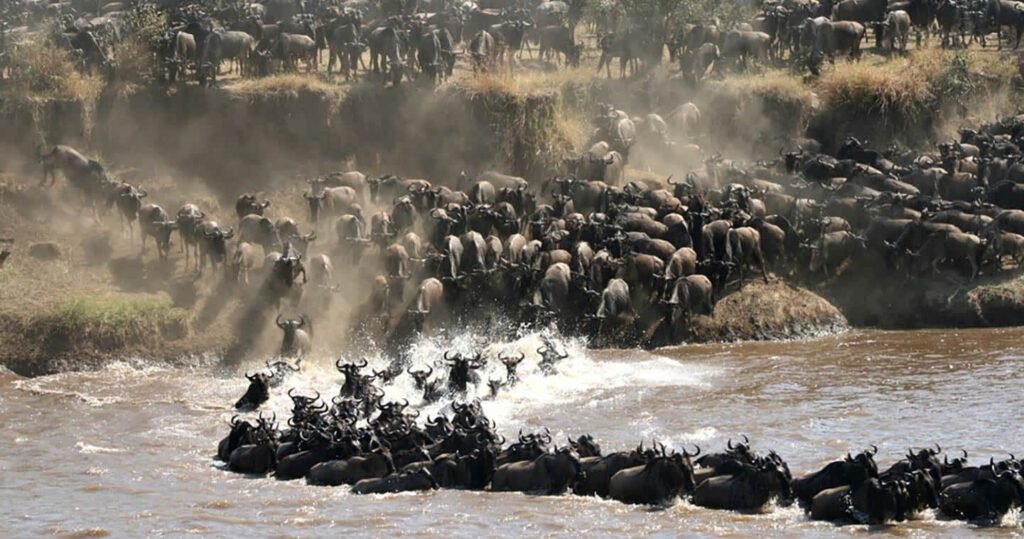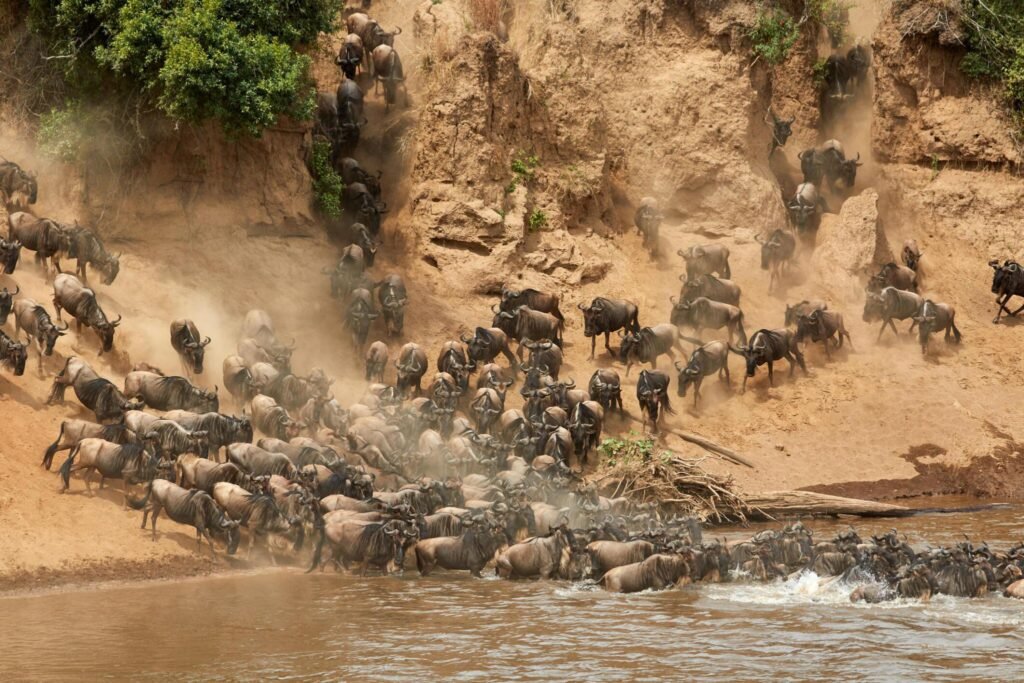Best Time to See the Great Migration : The Great Migration in Tanzania’s Serengeti and Kenya’s Maasai Mara is one of the most remarkable wildlife spectacles on Earth. Every year, over 1.5 million wildebeest, accompanied by zebras and gazelles, traverse these vast plains in search of greener pastures. This natural phenomenon is full of thrilling moments—from dramatic river crossings to the calving season, where thousands of wildebeest give birth. But when is the best time to see the Great Migration? In this guide, we’ll break down the best months to witness different stages of this incredible journey and how to plan your trip.
Explore Great Migration safaris here.

Best Time to See the Great Migration : Months & Wildlife Highlights – Understanding the Great Migration Cycle
The Great Migration is a year-round event, but different times of the year highlight different stages of the journey. From the calving season in the southern Serengeti to the perilous river crossings in the north, the migration follows a clockwise path. Knowing where the herds are at different times of the year can help you plan your trip to witness the most exciting events.
- Calving Season: December to March in the southern Serengeti.
- River Crossings: June to August in the western Serengeti and Maasai Mara.
- Return to South: October to November as the herds move back to the Serengeti.
Learn more about the stages of the migration here.
Best Time to See the Great Migration : Months & Wildlife Highlights – Best Time for Calving Season (December to March)
If you’re looking to witness the start of new life, the calving season is an excellent time to visit the Serengeti. From December to March, the herds gather in the southern Serengeti and the Ndutu region to give birth. Around 8,000 wildebeest calves are born each day, attracting predators like lions, cheetahs, and hyenas. This is the perfect time for those who want to see action-packed predator-prey interactions.
- Location: Southern Serengeti, Ndutu area.
- Highlights: Thousands of newborn calves, high predator activity, lush green landscapes.
Read more about the calving season in Ndutu.
Best Time to See the Great Migration : Months & Wildlife Highlights – Dramatic River Crossings (June to August)
The most iconic and heart-pounding event of the Great Migration is the river crossings. Between June and August, the herds must cross the Grumeti and Mara Rivers as they move north into Kenya’s Maasai Mara. These crossings are dangerous, as crocodiles lie in wait, and the swift currents can sweep animals away. This is the best time to witness the raw drama of nature in action.
- Location: Grumeti River (western Serengeti), Mara River (northern Serengeti/Maasai Mara).
- Highlights: Large herds braving crocodile-infested waters, spectacular wildlife photography opportunities.
Learn more about the Mara River crossings.
Best Time to See the Great Migration : Months & Wildlife Highlights – The Return to Serengeti (October to November)
After spending several months in the Maasai Mara, the herds begin their journey back to the southern Serengeti around October and November. During this time, they move through the eastern Serengeti, grazing as they go. This period is quieter, but it’s still a great time to witness the herds on the move.
- Location: Eastern and southern Serengeti.
- Highlights: Quieter safaris, herds returning to calving grounds, lush landscapes after the short rains.
Discover more about the migration’s return to the Serengeti.
Best Time to See the Great Migration : Months & Wildlife Highlights – Timing Your Safari: Month-by-Month Breakdown
Here’s a detailed look at the best months to experience the Great Migration, based on the various stages of the journey.
January to March (Calving Season)
This is the prime time for witnessing the birth of thousands of wildebeest calves. The southern Serengeti and Ndutu region are alive with wildlife, and predator action is at its peak.
Plan your calving season safari here.
April to May (Low Season)
The long rains during these months can make the roads muddy, but if you’re looking for fewer crowds, this is a great time to visit. You can still catch the herds grazing in the southern and central Serengeti.
Find tips on visiting during the rainy season here.
June to August (River Crossings)
This is the best time to witness the thrilling river crossings. The Grumeti and Mara Rivers become the stage for some of the most dramatic moments of the migration, as herds face treacherous waters and predators.
Explore safari options for the river crossings.
September to November (Migration in Maasai Mara and Return to Serengeti)
After crossing into the Maasai Mara, the herds begin their return to Tanzania around October. This is a great time to visit if you want to avoid the crowds but still see the migration in action.
Learn more about safaris during this time of year.
Choosing the Best Viewing Locations
The Great Migration spans across a vast area, so choosing the right location is key to maximizing your safari experience. Different regions of the Serengeti offer distinct advantages depending on the time of year.
Southern Serengeti and Ndutu
Best for the calving season from December to March, with wide-open plains and predator action.
Plan your visit to Ndutu here.
Western Corridor (Grumeti River)
A top spot for witnessing river crossings in June and July, with fewer crowds than the Mara River area.
Explore the western Serengeti and Grumeti safaris.
Northern Serengeti and Maasai Mara
The most famous location for river crossings, especially from July to September, as the herds cross the Mara River.
Learn more about the Mara River crossings and northern Serengeti.
The Importance of Timing and Flexibility
The Great Migration is a natural event, and the exact timing can vary depending on rainfall and other environmental factors. Therefore, it’s essential to remain flexible with your travel plans. Many safari operators recommend a window of a few weeks to increase your chances of witnessing the key moments of the migration, such as the river crossings.
- Flexibility: Plan for a broader time range to maximize your chances of seeing the herds.
- Local Knowledge: Rely on experienced guides who know the best places to find the migration.
Learn more about how to plan a flexible Great Migration safari.
What to Pack for Your Migration Safari
Packing for a Great Migration safari requires preparation. Here’s a list of essential items to ensure you’re ready for the Serengeti’s varied conditions:
- Clothing: Lightweight layers for warm days and cool nights, a waterproof jacket for the rainy season.
- Camera Gear: A good camera with a zoom lens to capture the wildlife up close.
- Binoculars: For spotting distant herds and predators.
- Sunscreen and Hat: Protect yourself from the sun during game drives.
- Sturdy Footwear: Comfortable shoes for walking safaris or exploring campgrounds.
Get more tips on what to pack for an African safari.

Conservation Efforts and Responsible Tourism
The Great Migration is not just a spectacle but also a critical part of the Serengeti’s ecosystem. Conservation efforts play a vital role in protecting this natural wonder for future generations. Responsible tourism practices help to support local communities and protect wildlife.
- Conservation Initiatives: Local and international organizations work to ensure the protection of the Serengeti and Maasai Mara ecosystems.
- How You Can Help: Choose eco-friendly lodges and support conservation projects through your safari.
Learn more about conservation efforts in the Serengeti.
Best Time to See the Great Migration : Months & Wildlife Highlights : Conclusion
The Great Migration is a once-in-a-lifetime experience that should be carefully planned to ensure you witness the most exciting moments. Whether you want to see the dramatic river crossings, the birth of thousands of wildebeest calves, or the quiet return of the herds to the Serengeti, there’s always something incredible happening during the migration. By knowing the best time to visit and the top viewing spots, you can ensure that your safari offers unforgettable wildlife encounters.
For more information on Great Migration safaris, visit Kilimanjaro Climb Specialist or Eddy Tours & Safaris.

